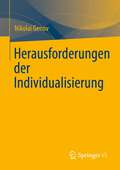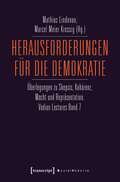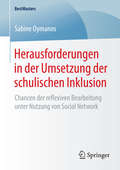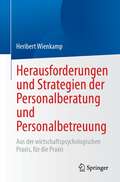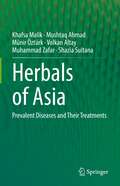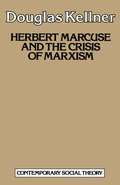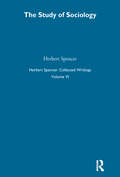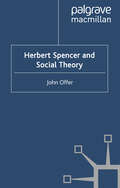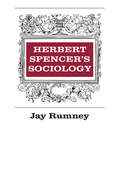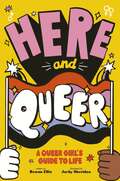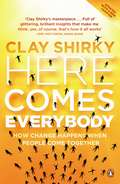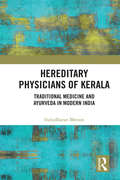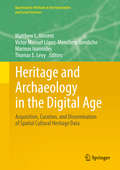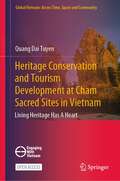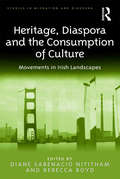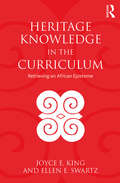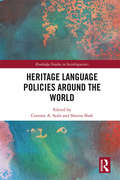- Table View
- List View
Herausforderungen der Individualisierung
by Nikolai GenovDieses Buch setzt sich kritisch mit einer Reihe von provokanten Fragen auseinander: Warum sind die heutigen Gesellschaften so abhängig von den konstruktiven und destruktiven Auswirkungen der Individualisierung? Ist dieses Phänomen nur mit der "zweiten" oder "späten" Moderne verbunden? Kann das Konzept der Individualisierung produktiv für die Entwicklung einer soziologischen Diagnose unserer Zeit genutzt werden? Die innovativen Antworten, die in diesem Buch vorgeschlagen werden, konzentrieren sich auf zwei Arten von Herausforderungen, die den Anstieg der Individualisierung begleiten. Erstens, dass sie durch umstrittene Veränderungen in den sozialen Strukturen und Handlungsmustern verursacht wird. Zweitens, dass die Auswirkungen der Individualisierung Varianten des Gemeinwohls in Frage stellen. Beide Herausforderungen haben eine lange Geschichte, haben aber in den fortgeschrittenen Gesellschaften der Gegenwart im Kontext der aktuellen Globalisierung eine kritische Intensität erreicht.
Herausforderungen für die Demokratie: Überlegungen zu Skepsis, Kohärenz, Macht und Repräsentation. Vadian Lectures Band 7 (Sozialtheorie)
by Mathias Lindenau Marcel Meier KressigDem bis vor wenigen Jahren weitgehend unangefochtenen Modell der liberalen Demokratie wird zunehmend ein Krisenmodus zugeschrieben. Globalisierte Problemlagen, populistische Trends, neonationalistisch-autoritäre Strömungen oder die veränderte Medienlandschaft scheinen die Fragilität des westlichen Demokratieverständnisses deutlich zum Ausdruck zu bringen. Statt aber vorschnell den Fortbestand der Demokratie anzuzweifeln, setzen sich die Beiträger des Bandes - Jens Hacke, Georg Kohler, Jan-Werner Müller und Herfried Münkler - mit ihren grundsätzlichen Fragestellungen auseinander.
Herausforderungen in der Umsetzung der schulischen Inklusion: Chancen der reflexiven Bearbeitung unter Nutzung von Social Network (BestMasters)
by Sabine OymannsSabine Oymanns verdeutlicht, dass inklusiver Unterricht mit vertrauten Konzepten und vorhandenen Ressourcen umgesetzt werden kann. Entsprechende Skizzen der Konzepte sowie methodologische Zugänge zur Aufdeckung vorhandener Ressourcen in den Kollegien und Schulteams sind Thema der Autorin. Dabei wird deutlich, dass die Umsetzung der Inklusion sich als eine multidimensionale, gesamtgesellschaftliche Herausforderung darstellt, welche mit den vorhandenen Ressourcen und geänderten Denken-Wegen in Netzwerken gelingen kann – Netzwerke, die sich reflexiv bilden.
Herausforderungen und Strategien der Personalberatung und Personalbetreuung: Aus der wirtschaftspsychologischen Praxis, für die Praxis
by Heribert WienkampPersonalmanagement bedeutet im Kern die Betreuung von Führungskräften und Mitarbeitenden und ist eine hochpolitische kommunikative Aufgabe. Zu Recht hat die Personalbetreuung den Ruf eines „Communication Champions“, da sie erster Ansprechpartner in allen beratungsrelevanten Personalfragen ist.Gemeinsam mit den Führungskräften übt der Personalbereich in der Funktion des Arbeitgebers das Direktionsrecht gegenüber den Betriebsangehörigen aus und kooperiert mit ihnen in allen Personalangelegenheiten. Personalentscheidungen dieser Akteure sind zumeist ambivalent mit pro und contra und stets Richtungsentscheidungen, die i.d.R. nicht revidierbar sind. Bei welchen Problemen und Schwierigkeiten die Personalberatung und Personalbetreuung gefordert ist und welchen konzeptionellen Input sie an wirtschaftspsychologischen und personalspezifischen Wissen leisten muss, erfahren Sie in diesem Buch. Hiervon ist nicht nur das tägliche Personalgeschäft betroffen, sondern auch die Gestaltung strategischerPersonalbetreuungskonzepte, die zu Inspirationen im Personalmanagement anregen.
Herbals of Asia: Prevalent Diseases and Their Treatments
by Khafsa Malik Mushtaq Ahmad Münir Öztürk Volkan Altay Muhammad Zafar Shazia SultanaMedicinal flora plays an important role in health care systems across the world. Out of the half million flowering plants, around 50.000 species are valued for their therapeutic properties. During the last few decades, 20% of the world’s population used plants and/or their derived products as a source of medicine. WHO stated that 80% population around the globe, specifically the rural communities, depend on medicinal plants for their basic healthcare needs. To this end, plant-based phytochemicals are known to have hepato-protective, anti-carcinogenic, anti-allergic, anti-inflammatory, antimicrobial, antioxidant actions. This book is a guide to ~280 plant species of medicinal flora that demonstrates global relevance. Our goal is to share local knowledge about phytomedicines to a worldwide audience. It is an illustrated reference that documents and preserves the existing knowledge on these plant taxa, with a social and cultural (ethnobotanical) emphasis. This book also provides comprehensive and useful information about traditional uses of medicinal plants by the local communities for the treatment of various prevalent diseases. It contains comprehensive descriptions of each species including family, synonyms, English name, distribution, altitude, habitat, morphological description, life form, part used, mode of utilization, diseases category, recipes, other medicinal uses, phytochemical activity and toxicity.
Herbert Spencer: Volume VI The Study of Sociology
by Herbert SpencerHerbert Spencer (1820-1903) was regarded by the Victorians as the foremost philosopher of the age, the prophet of evolution at a time when the idea had gripped the popular imagination. Until recently Spencer's posthumous reputation rested almost excusively on his social and political thought, which has itself frequently been subject to serious misrepresentation. But historians of ideas now recognise that an acquaintance with Spencer's thought is essential for the proper understanding of many aspects of Victorian intellectual life, and the present selection is designed to answer this need. It provides a cross-section of Spencer's works from his more popular and approachable essays to a number of the volumes of the Synthetic Philosophy itself. Volume VI The Study of Sociology.
Herbert Spencer: Volume VI The Study of Sociology (Works By And About Herbert Spencer Ser.)
by Herbert SpencerHerbert Spencer (1820-1903) was regarded by the Victorians as the foremost philosopher of the age, the prophet of evolution at a time when the idea had gripped the popular imagination. Until recently Spencer's posthumous reputation rested almost excusively on his social and political thought, which has itself frequently been subject to serious misrepresentation. But historians of ideas now recognise that an acquaintance with Spencer's thought is essential for the proper understanding of many aspects of Victorian intellectual life, and the present selection is designed to answer this need. It provides a cross-section of Spencer's works from his more popular and approachable essays to a number of the volumes of the Synthetic Philosophy itself. Volume VI The Study of Sociology.
Herbert Spencer and Social Theory
by J. OfferHerbert Spencer remains a significant but poorly understood figure in 19th century intellectual life. His ideas on evolution ranged across the natural sciences and philosophy, and he pioneered new ideas in psychology and sociology. This book comprehensively examines his work and strips away common misconceptions about his sociology.
Herbert Spencer's Sociology
by Jay RumneyThe republication of this book is eminently fitting at this time. Jay Rumney's Herbert Spencer's Sociology first appeared in 1937. In that year Talcott Parsons, citing Crane Brinton, declared: "Spencer is dead. But who killed him and how?" It was the thesis of Parsons' famous The Structure of Social Action that the evolution of scientific theory had put an end to Spencer. For more than a generation the man whose name had been synonymous with sociology was, or so it seemed, repressed and forgotten.
Herbert Spencer's Sociology
by Jay RumneyThe republication of this book is eminently fitting at this time. Jay Rumney's Herbert Spencer's Sociology first appeared in 1937. In that year Talcott Parsons, citing Crane Brinton, declared: "Spencer is dead. But who killed him and how?" It was the thesis of Parsons' famous The Structure of Social Action that the evolution of scientific theory had put an end to Spencer. For more than a generation the man whose name had been synonymous with sociology was, or so it seemed, repressed and forgotten.
Here And Queer
by Rowan EllisHere and Queer is a helpful, friendly guide full of support and advice about living your best queer life, written for girls. This vibrant, inclusive guide, designed for all kinds of girls, is designed to help you be the strongest, proudest, happiest version of yourself! A celebration of the gift of queerness, it's packed full of heartfelt advice, comforting stories and stylish illustrations, and will give you the tools you need to explore your own identity, on your own terms. Author and YouTuber Rowan Ellis uses her personal experience to take you through queer life, from coming out and dealing with tough stuff, right through to finding friendships and celebrating Pride. There are also brilliant guest essays from contributors across the LGBTQ+ spectrum. The book opens with guidance on understanding how you feel as a queer girl. From choosing your pronouns to navigating different labels and identities, Ellis helps girls understand that they are in control of their own identity, and that it's ok to not be sure straight away. Moving onto a glossary of queer terms, Here and Queer helps introduce girls to the rainbow of definitions and terms which help queer people understand who they are and how they feel. The book then moves onto advice on coming out, for many one of the hardest steps to take on their journey to truly living their best lives. Following are chapters on sex and romance, including helpful advice about your first time, as well as guides on consent and knowing how to make sure you build a healthy and supportive relationship with your partner. There are also sections on dealing with bullies and stigma, finding your community and looking after your mental health, including advice on how to help you find extra support if you need it. The book also has more information on queer ladies in history, and on the fight for equality undertaken by brave activists throughout history and today. Stylishly designed with cool illustrations, this friendly and supportive book will help all queer girls navigate the challenges of discovering and embracing their identities and flourishing in their own skins!
Here And Queer (PDF)
by Rowan EllisHere and Queer is a helpful, friendly guide full of support and advice about living your best queer life, written for girls. This vibrant, inclusive guide, designed for all kinds of girls, is designed to help you be the strongest, proudest, happiest version of yourself! A celebration of the gift of queerness, it's packed full of heartfelt advice, comforting stories and stylish illustrations, and will give you the tools you need to explore your own identity, on your own terms. Author and YouTuber Rowan Ellis uses her personal experience to take you through queer life, from coming out and dealing with tough stuff, right through to finding friendships and celebrating Pride. There are also brilliant guest essays from contributors across the LGBTQ+ spectrum. The book opens with guidance on understanding how you feel as a queer girl. From choosing your pronouns to navigating different labels and identities, Ellis helps girls understand that they are in control of their own identity, and that it's ok to not be sure straight away. Moving onto a glossary of queer terms, Here and Queer helps introduce girls to the rainbow of definitions and terms which help queer people understand who they are and how they feel. The book then moves onto advice on coming out, for many one of the hardest steps to take on their journey to truly living their best lives. Following are chapters on sex and romance, including helpful advice about your first time, as well as guides on consent and knowing how to make sure you build a healthy and supportive relationship with your partner. There are also sections on dealing with bullies and stigma, finding your community and looking after your mental health, including advice on how to help you find extra support if you need it. The book also has more information on queer ladies in history, and on the fight for equality undertaken by brave activists throughout history and today. Stylishly designed with cool illustrations, this friendly and supportive book will help all queer girls navigate the challenges of discovering and embracing their identities and flourishing in their own skins!
Here Comes Everybody: How Change Happens when People Come Together
by Clay ShirkyWelcome to the new future of involvement. Forming groups is easier than it's ever been: unpaid volunteers can build an encyclopaedia together in their spare time, mistreated customers can join forces to get their revenge on airlines and high street banks, and one man with a laptop can raise an army to help recover a stolen phone.The results of this new world of easy collaboration can be both good (young people defying an oppressive government with a guerrilla ice-cream eating protest) and bad (girls sharing advice for staying dangerously skinny) but it's here and, as Clay Shirky shows, it's affecting ... well, everybody. For the first time, we have the tools to make group action truly a reality. And they're going to change our whole world.
Hereditary Physicians of Kerala: Traditional Medicine and Ayurveda in Modern India
by Indudharan MenonThis book examines the history and evolution of Ayurveda and other indigenous medical traditions in juxtaposition with their encounter with colonial modernity. Through the lens of hereditary folk and Ayurvedic practitioners, it focuses on Kerala’s heterogeneous medical traditions and presents them against the backdrop of the geographical, historical, sociocultural, ethnographic and regional contexts in which they developed and transformed. The author explores the world of Kerala’s last traditionally trained hereditary practitioners (folk healers, poison therapists, Sanskrit-speaking Muslim Ayurvedic practitioners and the legendary Brahman Ashtavaidyan physicians). He discusses the views of these physicians regarding the marked difference between their personalised ancestral methods of treatment and the standardised version of Ayurveda compliant with biomedicine that is practised by doctors today. Drawing on extensive fieldwork, this book will be useful to researchers and scholars of medical anthropology, health and social medicine, sociology and social anthropology, the history of science and modern Indian history, as well as to medical practitioners interested in alternative and traditional medicine.
Hereditary Physicians of Kerala: Traditional Medicine and Ayurveda in Modern India
by Indudharan MenonThis book examines the history and evolution of Ayurveda and other indigenous medical traditions in juxtaposition with their encounter with colonial modernity. Through the lens of hereditary folk and Ayurvedic practitioners, it focuses on Kerala’s heterogeneous medical traditions and presents them against the backdrop of the geographical, historical, sociocultural, ethnographic and regional contexts in which they developed and transformed. The author explores the world of Kerala’s last traditionally trained hereditary practitioners (folk healers, poison therapists, Sanskrit-speaking Muslim Ayurvedic practitioners and the legendary Brahman Ashtavaidyan physicians). He discusses the views of these physicians regarding the marked difference between their personalised ancestral methods of treatment and the standardised version of Ayurveda compliant with biomedicine that is practised by doctors today. Drawing on extensive fieldwork, this book will be useful to researchers and scholars of medical anthropology, health and social medicine, sociology and social anthropology, the history of science and modern Indian history, as well as to medical practitioners interested in alternative and traditional medicine.
Heritage and Archaeology in the Digital Age: Acquisition, Curation, and Dissemination of Spatial Cultural Heritage Data (Quantitative Methods in the Humanities and Social Sciences)
by Matthew L. Vincent Víctor Manuel López-Menchero Bendicho Marinos Ioannides Thomas E. LevyThis book examines how computer-based programs can be used to acquire ‘big’ digital cultural heritage data, curate, and disseminate it over the Internet and in 3D visualization platforms with the ultimate goal of creating long-lasting “digital heritage repositories.’ The organization of the book reflects the essence of new technologies applied to cultural heritage and archaeology. Each of these stages bring their own challenges and considerations that need to be dealt with. The authors in each section present case studies and overviews of how each of these aspects might be dealt with. While technology is rapidly changing, the principles laid out in these chapters should serve as a guide for many years to come. The influence of the digital world on archaeology and cultural heritage will continue to shape these disciplines as advances in these technologies facilitate new lines of research. serif">The book is divided into three sections covering acquisition, curation, and dissemination (the major life cycles of cultural heritage data). Acquisition is one of the fundamental challenges for practitioners in heritage and archaeology, and the chapters in this section provide a template that highlights the principles for present and future work that will provide sustainable models for digital documentation. Following acquisition, the next section highlights how equally important curation is as the future of digital documentation depends on it. Preservation of digital data requires preservation that can guarantee a future for generations to come. The final section focuses on dissemination as it is what pushes the data beyond the shelves of storage and allows the public to experience the past through these new technologies, but also opens new lines of investigation by giving access to these data to researchers around the globe. Digital technology promises significant changes in how we approach social sciences, cultural heritage, and archaeology. However, researchers must consider not only the acquisition and curation, but also the dissemination of these data to their colleagues and the public.Throughout the book, many of the authors have highlighted the usefulness of Structure from Motion (SfM) work for cultural heritage documentation; others the utility and excitement of crowdsourcing as a ‘citizen scientist’ tool to engage not only trained students and researchers, but also the public in the cyber-archaeology endeavor. Both innovative tools facilitate the curation of digital cultural heritage and its dissemination. Together with all the chapters in this volume, the authors will help archaeologists, researchers interested in the digital humanities and scholars who focus on digital cultural heritage to assess where the field is and where it is going.
Heritage Conservation and Tourism Development at Cham Sacred Sites in Vietnam: Living Heritage Has A Heart (Global Vietnam: Across Time, Space and Community)
by Quang Dai TuyenThis open access book considers the growing field of heritage tourism from community perspectives. It explores how the Cham—Vietnam’s large ethnic minority—reconcile their needs for economic development with the boundaries circumscribed by their traditional culture. It examines struggles that local minority stakeholders like the Cham face when trying to participate in areas of development that typically fall under State control. How will tourism affect the ancient sacred spaces that are the Cham’s lifeblood? In what areas is their participation permitted? From what areas are they excluded? Through a novel mix of indigenous methods, participant observation, local voices, and rich ethnographic description, this book provides a rare glimpse into the discourses that have been percolating throughout the community in recent years. The relevance of this study extends beyond the Cham community, and aims to resonate with experiences of the myriad indigenous and minority communities around the world who face similar issues with heritage conservation and tourism development. This book is of interest to students and researchers of heritage studies, tourism management, cultural studies, Asian studies, as well as policymakers, and academicians seeking current research on the connections between culture, conservation, sustainable development, and tourism.
Heritage, Diaspora and the Consumption of Culture: Movements in Irish Landscapes (Studies in Migration and Diaspora)
by Diane Sabenacio Nititham Rebecca BoydUsing an interdisciplinary and transhistorical framework this book examines the cultural, material, and symbolic articulations of Irish migration relationships from the medieval period through to the contemporary post-Celtic Tiger era. With attention to people’s different uses of social space, relationships with and memories of the landscape, as well as their symbolic expressions of diasporic identity, Heritage, Diaspora and the Consumption of Culture examines the different forms of diaspora over time and contributes to contemporary debates on home, foreignness, globalization and consumption. By examining various movements of people into and out of Ireland, the book explores how expressions of cultural capital and symbolic power have changed over time in the Irish collective imagination, shedding light on the ways in which Ireland is represented and Irish culture consumed and materialized overseas. Arranged around the themes of home and location, identity and material culture, and global culture and consumption, this collection brings together the work of scholars from the UK, Ireland, Europe, the US and Canada, to explore the ways in which the processes of movement affect the people’s negotiation and contestation of concepts of identity, the local and the global. As such, it will appeal to scholars working in fields such as sociology, politics, cultural studies, history and archaeology, with interests in migration, gender studies, diasporic identities, heritage and material culture.
Heritage, Diaspora and the Consumption of Culture: Movements in Irish Landscapes (Studies in Migration and Diaspora)
by Diane Sabenacio Nititham Rebecca BoydUsing an interdisciplinary and transhistorical framework this book examines the cultural, material, and symbolic articulations of Irish migration relationships from the medieval period through to the contemporary post-Celtic Tiger era. With attention to people’s different uses of social space, relationships with and memories of the landscape, as well as their symbolic expressions of diasporic identity, Heritage, Diaspora and the Consumption of Culture examines the different forms of diaspora over time and contributes to contemporary debates on home, foreignness, globalization and consumption. By examining various movements of people into and out of Ireland, the book explores how expressions of cultural capital and symbolic power have changed over time in the Irish collective imagination, shedding light on the ways in which Ireland is represented and Irish culture consumed and materialized overseas. Arranged around the themes of home and location, identity and material culture, and global culture and consumption, this collection brings together the work of scholars from the UK, Ireland, Europe, the US and Canada, to explore the ways in which the processes of movement affect the people’s negotiation and contestation of concepts of identity, the local and the global. As such, it will appeal to scholars working in fields such as sociology, politics, cultural studies, history and archaeology, with interests in migration, gender studies, diasporic identities, heritage and material culture.
Heritage Knowledge in the Curriculum: Retrieving an African Episteme
by Joyce E. King Ellen E. SwartzMoving beyond the content integration approach of multicultural education, this text powerfully advocates for the importance of curriculum built upon authentic knowledge construction informed by the Black intellectual tradition and an African episteme. By retrieving, examining, and reconnecting the continuity of African Diasporan heritage with school knowledge, this volume aims to repair the rupture that has silenced this cultural memory in standard historiography in general and in PK-12 curriculum content and pedagogy in particular. This ethically informed curriculum approach not only allows students of African ancestry to understand where they fit in the world but also makes the accomplishments and teachings of our collective ancestors available for the benefit of all. King and Swartz provide readers with a process for making overt and explicit the values, actions, thoughts, and behaviors reflected in an African episteme that serves as the foundation for African Diasporan sociohistorical phenomenon/events. With such knowledge, teachers can conceptualize curriculum and shape instruction that locates people in all cultures as subjects with agency whose actions embody their ongoing cultural legacy.
Heritage Knowledge in the Curriculum: Retrieving an African Episteme
by Joyce E. King Ellen E. SwartzMoving beyond the content integration approach of multicultural education, this text powerfully advocates for the importance of curriculum built upon authentic knowledge construction informed by the Black intellectual tradition and an African episteme. By retrieving, examining, and reconnecting the continuity of African Diasporan heritage with school knowledge, this volume aims to repair the rupture that has silenced this cultural memory in standard historiography in general and in PK-12 curriculum content and pedagogy in particular. This ethically informed curriculum approach not only allows students of African ancestry to understand where they fit in the world but also makes the accomplishments and teachings of our collective ancestors available for the benefit of all. King and Swartz provide readers with a process for making overt and explicit the values, actions, thoughts, and behaviors reflected in an African episteme that serves as the foundation for African Diasporan sociohistorical phenomenon/events. With such knowledge, teachers can conceptualize curriculum and shape instruction that locates people in all cultures as subjects with agency whose actions embody their ongoing cultural legacy.
Heritage Language Policies around the World (Routledge Studies in Sociolinguistics)
by Corinne A. Seals Sheena ShahHeritage language policies define the context in which heritage languages are maintained or abandoned by communities, and this volume describes and analyzes international policy strategies, as well as the implications for the actual heritage language speakers. This volume brings together heritage language policy case studies from around the world, foregrounding globalization by covering five regions: the Americas, Europe, Africa, Asia, and Australasia. The countries profiled include the United States, Canada, Argentina, Norway, Sweden, Ireland, Uganda, Namibia, Morocco, Japan, South Korea, Singapore, New Zealand, Australia, and Fiji. This volume also highlights an expanded definition of ‘heritage language’, choosing to focus on individual and community identities, and therefore including both Indigenous and immigrant languages. Focusing specifically on language policy relating to heritage languages, the chapters address key questions such as Are heritage languages included or excluded from the national language policy discourse? What are the successes and shortcomings of efforts to establish heritage language policies? What is the definition of ‘heritage language’ in official usage by the local/regional government and stakeholders? How are these language policies perceived by the actual heritage language communities?
Heritage Language Policies around the World (Routledge Studies in Sociolinguistics)
by Corinne A. Seals Sheena ShahHeritage language policies define the context in which heritage languages are maintained or abandoned by communities, and this volume describes and analyzes international policy strategies, as well as the implications for the actual heritage language speakers. This volume brings together heritage language policy case studies from around the world, foregrounding globalization by covering five regions: the Americas, Europe, Africa, Asia, and Australasia. The countries profiled include the United States, Canada, Argentina, Norway, Sweden, Ireland, Uganda, Namibia, Morocco, Japan, South Korea, Singapore, New Zealand, Australia, and Fiji. This volume also highlights an expanded definition of ‘heritage language’, choosing to focus on individual and community identities, and therefore including both Indigenous and immigrant languages. Focusing specifically on language policy relating to heritage languages, the chapters address key questions such as Are heritage languages included or excluded from the national language policy discourse? What are the successes and shortcomings of efforts to establish heritage language policies? What is the definition of ‘heritage language’ in official usage by the local/regional government and stakeholders? How are these language policies perceived by the actual heritage language communities?
Heritage-Making in Hong Kong Through Culture and Religion
by Trevor Sofield Lawal Mohammed Marafa Fung Mei Li Kwo Fung ShekThis book centres on religious heritage-making where religion as a rich and diverse manifestation of culture and community empowerment lead to the transformation of place. Fusing heritage and religion in the novel multidisciplinary concept ‘heri-ligion’, the authors illuminate the dynamics of change inherent in religious-oriented heritage-making. Grounded in empirical evidence, this rich concept integrates religious tourism, heritage tourism, and community-based empowerment for sustainable development. Applying this unique concept to the once abandoned Hakka village of Yim Tin Tsai, the authors analyse the evolving paths of the island from its Hakka origins to a Christian pilgrimage site, and more recently, to a UNESCO cultural heritage site and thriving tourist destination. The authors foreground the important role of the scattered community as a key agent of change in facilitating a sustainable environment of Hong Kong’s only salt-producing place today. A dynamic example of community development and empowerment founded upon religious, cultural, industrial and natural heritage, this book uniquely contributes to tourism and heritage studies, human geography, cultural sociology, Hakka studies, Asian studies, and anthropology of religion.
